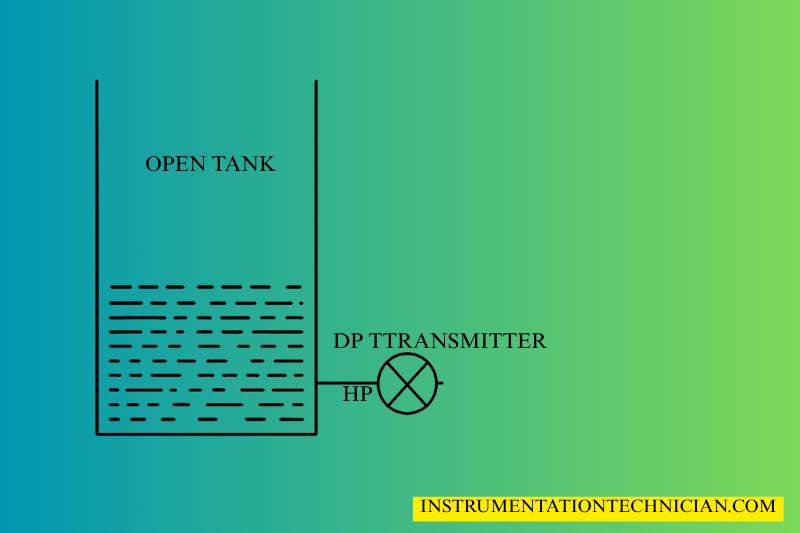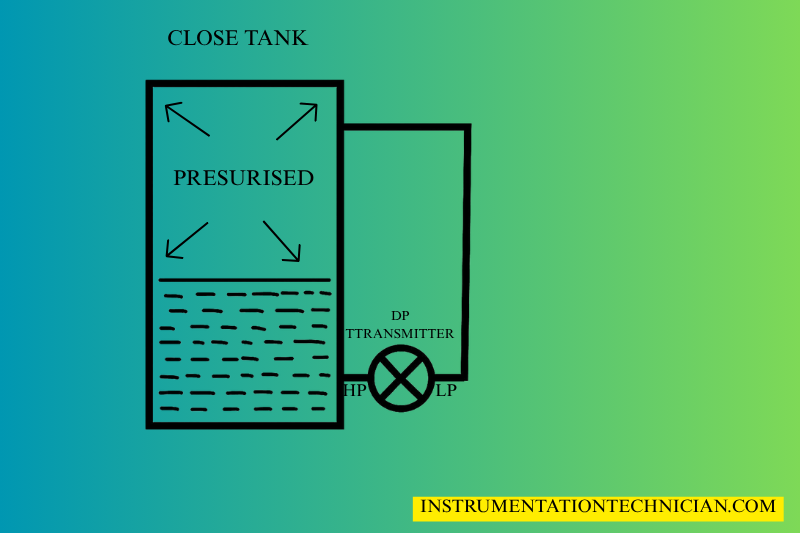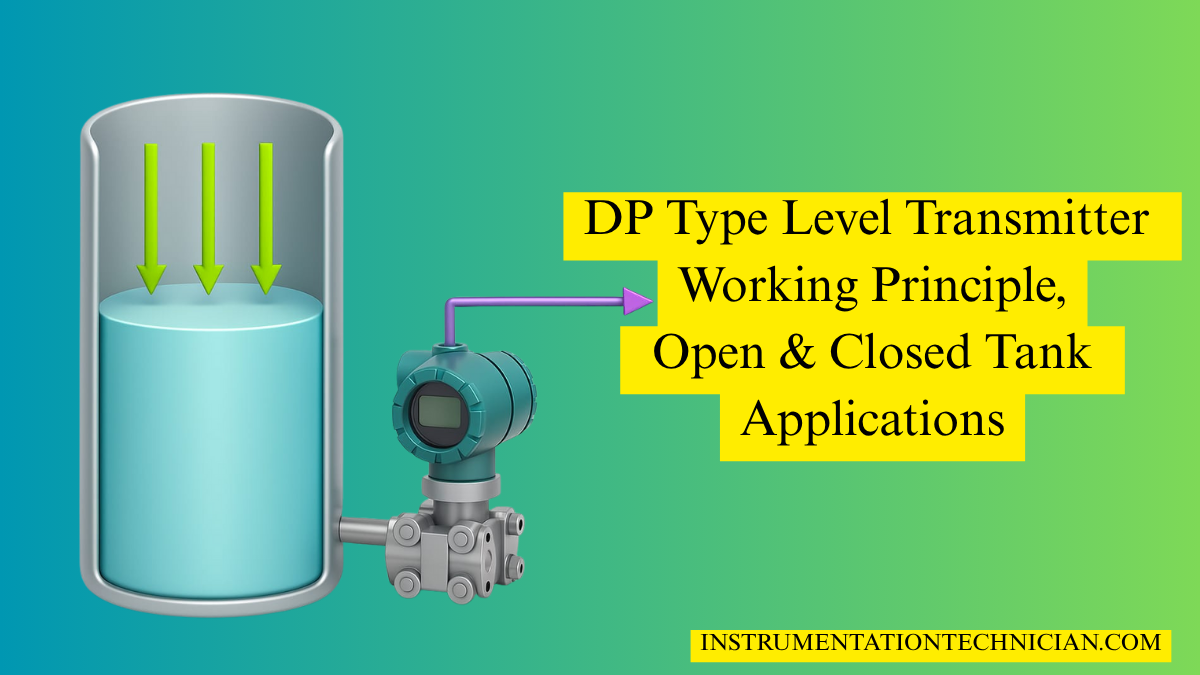जब किसी tank या vessel में liquid का level measure होता है, तब हम DP Type Level Transmitter का use करते हैं। “DP” का मतलब होता है Differential Pressure, यानी दो points के बीच का Pressure फर्क। इसी फर्क से transmitter ये पता लगाता है कि tank में कितना liquid भरा हुआ है।
ये तरीका बहुत accurate होता है, इसलिए इसे refinery, chemical plants, और power plants जैसी जगहों पर use किया जाता है।
DP (Differential Pressure) Transmitter को level measurement के लिए इसलिए use किया जाता है क्योंकि यह बहुत accurate और reliable होता है — खासकर जब बात आती है high या low pressure वाले tanks की।
Working Principle – DP Type Level Transmitter
DP Transmitter का मतलब है Differential Pressure Transmitter, जो किसी भी टैंक या वेसल में liquid का level मापने के लिए दो points का pressure compare करता है — एक low point और एक high point।
जैसे-जैसे टैंक में liquid का level बढ़ता है, नीचे वाला pressure point ज्यादा दबाव महसूस करता है। ऊपर वाला comparatively कम।
यही difference transmitter को signal देता है, और वह उसे electronic signal में बदलकर level बता देता है।
Formula:
ΔP = ρ × g × h
जहां,
ΔP = Differential Pressure (Pressure difference)
ρ (rho) = Liquid की density
g = Gravitational acceleration
h = Liquid की height (यानी level)
यानी transmitter level को pressure के हिसाब से calculate करता है।
🧪 Example:
मान लो एक टैंक में clean acid liquid है और उसका density है 1000 kg/m³. अगर liquid का height 2 meter है, तो:
ΔP = 1000 × 9.81 × 2 = 19620 Pascal (Pa)
Transmitter इस pressure को detect करता है और इसे level में convert करके output देता है।
Real-Life Analogy:
जैसे जब हम हाथ पानी में डालते हैं, और जैसे-जैसे गहराई बढ़ती है, वैसे-वैसे दबाव ज़्यादा महसूस होता है। DP transmitter भी यही logic apply करता है — जितना ज्यादा level, उतना ज्यादा pressure difference।
Types of DP Level Measurement
DP Type Level Transmitter को दो तरह के tank में use किया जाता है – Open Tank और Closed Tank. दोनों का structure और pressure condition अलग होता है, इसलिए measurement technique भी थोड़ी बदलती है।
1. Open Tank (Atmospheric Tank) – Dry Leg System के साथ
जब कोई tank ऊपर से खुला होता है — जैसे कि water tank या chemical का कोई storage tank — तो उसे Open Tank कहा जाता है। इस तरह के tank में top पर कोई pressure नहीं होता, यानी atmospheric pressure ही directly surface पर लगता है।

इस case में हमें सिर्फ tank के bottom से pressure मापना होता है, क्योंकि वही liquid का real height-based pressure होता है।
DP Transmitter में दो ports होते हैं —
- HP (High Pressure) Side
- LP (Low Pressure) Side
Open Tank में:
- HP Side को tank के bottom से जोड़ा जाता है
- LP Side को atmosphere में open छोड़ दिया जाता है या खाली छोड़ दिया जाता है
क्यों?
क्योंकि LP side से कोई pressure measure करने की जरूरत नहीं होती — tank के ऊपर already atmosphere का pressure है, जो LP port पर भी पड़ता है। इसलिए ये system Dry Leg कहलाता है — मतलब LP line में कोई liquid नहीं होता, बस open रहता है।
इससे जो pressure difference transmitter को मिलता है, वो सीधा tank में भरे हुए liquid के level को दिखाता है।
2. Closed Tank – Wet Leg System के साथ
Closed Tank यानी ऐसा tank जो पूरी तरह seal होता है – यानी उसमें ऊपर से भी pressure apply होता है, जैसे steam pressure, nitrogen blanket या gas pad।
ऐसे टैंक में liquid के level को accurately measure करने के लिए DP Transmitter का use किया जाता है — और इसमें दोनों ports (HP & LP) काम में लिए जाते हैं:
तो आपके बनाए हुए 2D diagram में जो दोनों side से connections दिखाए गए हैं, वो एक typical Closed Tank Wet Leg Application का ही example है।

- HP (High Pressure) Side: टैंक के bottom से connect किया जाता है – यहाँ से liquid column का pressure मिलता है।
- LP (Low Pressure) Side: टैंक के top से connect होता है – यहाँ से gas या vapor pressure का असर आता है।
अब बात आती है Wet Leg की।
LP side में कभी-कभी steam या moist gas होता है, जो condense होकर line में पानी भर देता है। ताकि reading accurate रहे, हम जान-बूझकर LP लाइन में पानी भरकर रखते हैं — इसे कहते हैं Wet Leg system।
इससे फायदा क्या होता है?
➡️ LP side में हमेशा constant liquid column बना रहता है
➡️ Measurement stable और accurate रहता है
➡️ LP pressure भी liquid में convert हो जाता है, जिससे DP transmitter आसानी से difference निकालता है
FAQ – DP Type Level Transmitter
What is a DP Level Transmitter?
DP (Differential Pressure) Level Transmitter एक ऐसा instrument होता है जो किसी tank या vessel में liquid का level measure करता है, दो points के बीच का pressure difference calculate करके। ये especially closed tanks में use होता है, जहाँ top aur bottom दोनों पर pressure लिया जाता है।
What does DP Level Mean?
DP Level का मतलब है “Differential Pressure based Level Measurement” — यानी liquid के column का height indirectly measure किया जाता है, pressure difference से।
Formula होता है:
DP = ρ × g × h
जहाँ ρ = density, g = gravity, और h = height of liquid.
How accurate is a DP Type Level Transmitter?
DP type transmitter की accuracy depend करती है calibration, installation aur process fluid की properties पर। Normally ये ±0.2% to ±0.5% तक accurate होता है। Regular maintenance और सही range selection से इसकी performance और बेहतर होती है।
How to calculate DP Type Level Transmitter Range?
Range निकालने के लिए सबसे पहले liquid की density, tank की height, aur अगर top pressure है तो उसे भी consider करना होता है।
Example:
For a 3-meterअगर आपको DP Type Level Transmitter से जुड़ी कोई भी confusion है — या आप किसी खास टॉपिक पर article चाहते हैं — तो बेझिझक कमेंट या मैसेज करें। tank with water (ρ = 1000 kg/m³),
DP max = 1000 × 9.81 × 3 = 29.43 kPa
तो transmitter की range होगी 0 to 29.43 kPa
अगर आपको DP Type Level Transmitter से जुड़ी कोई भी confusion है — या आप किसी खास topic पर article चाहते हैं तो बेझिझक comment करें।

1 thought on “DP Type Level Transmitter क्या होता है? जानिए Working Principle, Open & Closed Tank Applications”